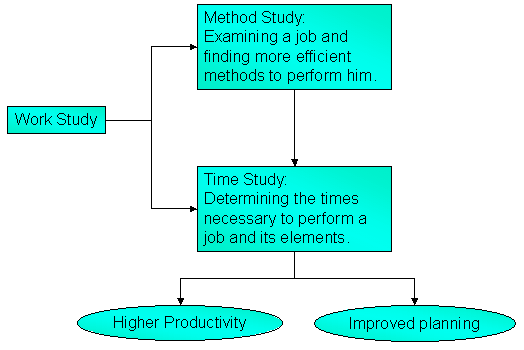An Overview of Work Study in Textile Industry

Rahamat Ullah Joy
B.sc in Textile Engineering
Daffodil International University
Email: rahamat.tex@gamil.com
Phone: +8801614445257
Introduction
Productivity has now become an everyday watch word. It is crucial to the welfare of industrial firm as well as for the economic progress of the country. High productivity refers to doing the work in a shortest possible time with least expenditure on inputs without sacrificing quality and with minimum wastage of resources.
Work-study forms the basis for work system design. The purpose of work design is to identify the most effective means of achieving necessary functions. This work-study aims at improving the existing and proposed ways of doing work and establishing standard times for work performance.
Work-study is encompassed by two techniques, i.e., method study and work measurement.
“Method study is the systematic recording and critical examination of existing and Proposed ways of doing work, as a means of developing and applying easier and more Effective methods and reducing costs.”
“Work measurement is the application or techniques designed to establish the time for A qualified worker to carry out a specified job at a defined level or performance.”
What is Work Study?
Work Study is the systematic examination of the methods of carrying out activities such as to improve the effective use of resources and to set up standards of performance for the activities carried out.
We can see through a Picture then we understand very smoothly
 |
Components of Work Study:
Another definition of Work Study could be:
"A generic term for those techniques, particularly method study and work measurement, which are used in the examination of human work in all its contexts, and which lead systematically to to the investigation of all the factors which affect the efficiency and economy of the situation being reviewed, in order to effect improvement.”
This has to do with Productivity Improvement, but also improvement of Quality and Safety.
Operations Management - Work Study:
Managing people within operations involves actual design decisions about jobs, methods, relationships between jobs and machines and systems of control and communication. Work design involves complex “people” relationships between operative staff, supervisors and specialists e.g. engineering managers and staff who commission new machines and maintain them. Other specialists may co-ordinate health and safety systems or monitor performance and plan maintenance .People are not mere extensions to machines or horsepower to be switched on and off. A worker’s performance may be better than a machine’s capability - yet a machine may outstrip the human being for many tasks.
People can be hurt/injured physically by operating environments or trapped socially and psychologically in them/by them. How operational systems are designed and the jobs and performance relationships within them are of great operational, economic and social importance. In this context then work study is
“A collection of techniques used to examine work - what is done and how it is done - so that there is systematic analysis of all the elements, factors, resources and relationships affecting the efficiency and effectiveness of the work being studied.”
Focusing point
Considerable diplomacy and sensitivity is needed by the industrial engineer or operations manager who becomes involved in work study (or business process improvement) investigations.
In the Path of F. W. Taylor:
Method study and work measurement are two principal activities of work study which originated in the work of F. W. Taylor . FW’s “scientific management” imperatives are:
- Investigate the work situation and identify weaknesses - where and why is poor performance happening? The “scientific” title for this approach to management means placing emphasis on data gathering and rational analysis
- Certain narrow assumptions about the objectivity of efficiency criteria.
- The existence of direct, deterministic relationships between worker performance and incentive payments and
- Consideration of the worker to some extent as a machine. Thus we can evaluate and introduce improvements in operating methods. This includes type of equipment, its use, layout of operations, supply and use of materials, materials handling, work organisation, effectiveness of planning procedures and so on. Productivity improvement is the aim.
- We can select staff with characteristics that fit the job, train and reward them using payment schemes the offer particular economic incentive by linking payment to measured performance. Such propositions are commonly the stuff of managerial populists and “how-to” texts on human resource management.
Is an analysis of ways of doing work? The mnemonic SREDIM (a common-sense heuristic or general problem solving strategy) represents the method study stages
- Select the tasks to study
- Record the facts about it
- Examine these
- Develop a new method
- Install/implement it
- Maintain it
Involves assessing the time a job should take to do. Similar steps are
Involved as to method study
- Select the tasks
- Record the facts
- Analyze them
- Calculate basic and standard times for the task
- Agree the method and its related time
Thus the techniques, assumptions and weaknesses of work study reflect important know-how for the operations manager generally - and not just those working in engineering or manufacturing environments. However the assumptions, difficulties and limitations of the claims must be understood.
Efficiency Indices
Using data on measured work, unmeasured work and idle time we can Attempt to derive effectiveness indices. Constable and New exemplify
Efficiency and effectiveness indices
A. efficiency
While performing measured work (ratio of standard/measured hours of Work produced and the actual time taken)
B. effectiveness
Which Includes?
- Accounting for work done for which no measured time Exists. Such work is typically paid for by an agreed hourly/day rate i.e. there is no direct, measured relationship between pay and how much work is actually completed in that hour. Of course a supervisor may pass a judgment or state that the amount of work and its quality are inadequate.
- Recognition of possible idle time caused e.g. by management not allocating any work, supplier/materials delays, machine breakdowns etc.
- It helps to achieve the smooth production flow with minimum interruptions.
- It helps to reduce the cost of the product by eliminating waste and unnecessary operations.
- Better worker-management relations.
- Meets the delivery commitment.
- Reduction in rejections and scrap and higher utilization of resources of the organization.
- Helps to achieve better working conditions.
- Better workplace layout.
- Improves upon the existing process or methods and helps in standardization and simplification.
- Helps to establish the standard time for an operation or job which has got application in manpower planning, production planning.
- It’s solve the hazard of operator through the industrial engineer
- And work study help to data entry option.
In simple terms work study measures work and defines (some) performance standards. There are many uses for time estimates for tasks. Operations managers can guess or assume that a job is done in the correct time (whatever that is!) or they can be systematic and use time data gathered by a systematic technique which has reasonable accuracy. Whether or not the worker likes it - pushed hard in trying to complete a job with very tight measured work standards which don’t anticipate the knotty problem encountered with a particular task- is another matter. Work study/industrial engineers need time data to plan and evaluate production/transformation processes. Rewards systems need such data for performance related bonuses. Cost calculations need to incorporate operative and machine job times Costing systems reference work study data. Work study data contributes too
And finally
We need to remember always that performance inefficiency may arise from many reasons outside of worker control - a cumbersome planning system, a slow computer system with heavy overheads, lack of investment or uninformed, disorganized management. It is crass to assume that the problems will only be due to staff inefficiencies or inappropriate methods.
References:
- http://textilelearner.blogspot.com/2013/07/what-is-work-study-work-study-in.html
- http://www.onlineclothingstudy.com/2011/09/how-to-do-method-study-for-garment.html
- http://www.onlineclothingstudy.com/2011/03/how-to-do-time-study-for-garment.html
- http://www.onlineclothingstudy.com/2012/02/20-ways-to-improve-productivity-in.html
- http://en.wikipedia.org/wiki/Work_study














No Responses to "An Overview of Work Study in Textile Industry"